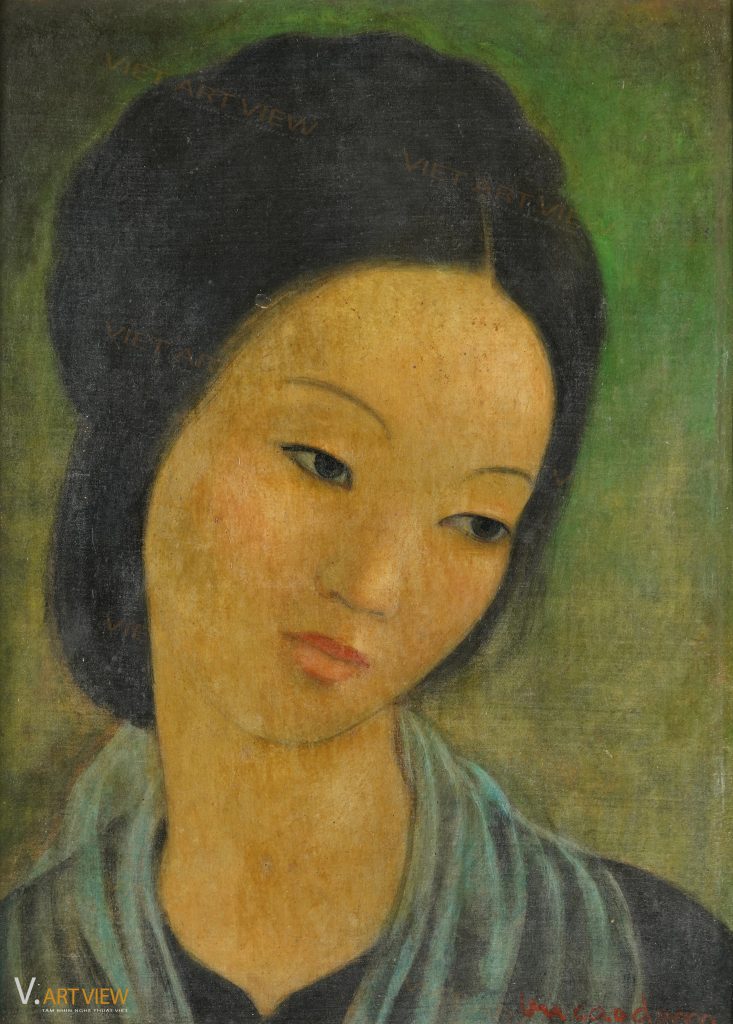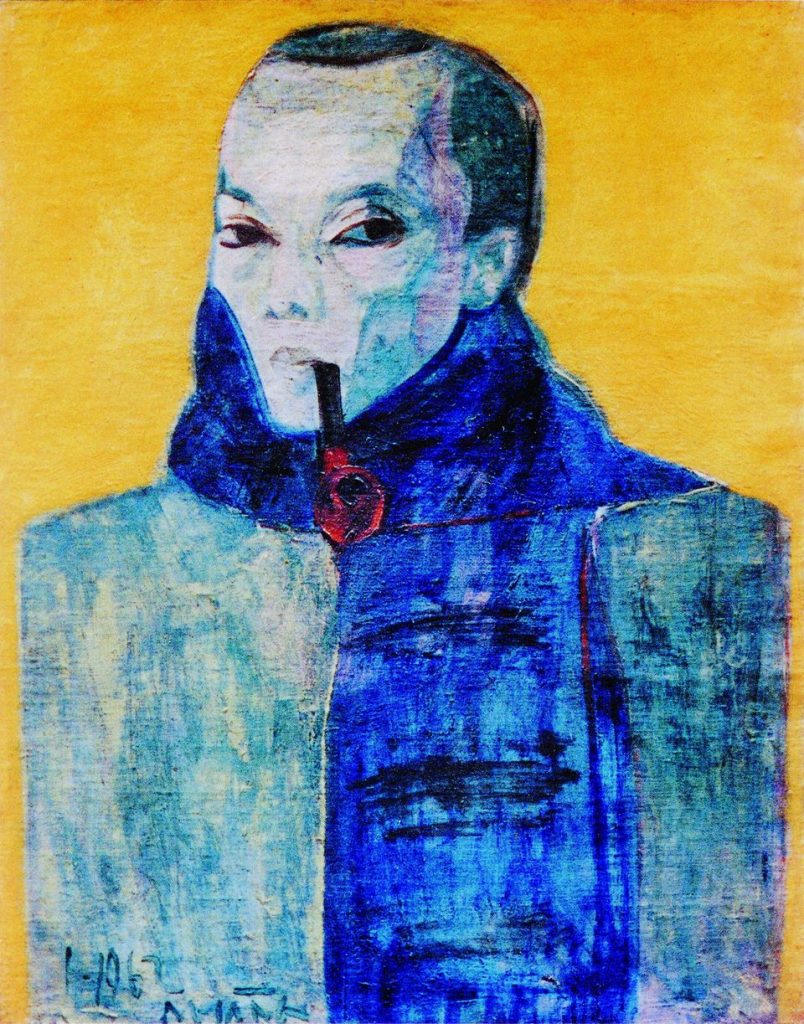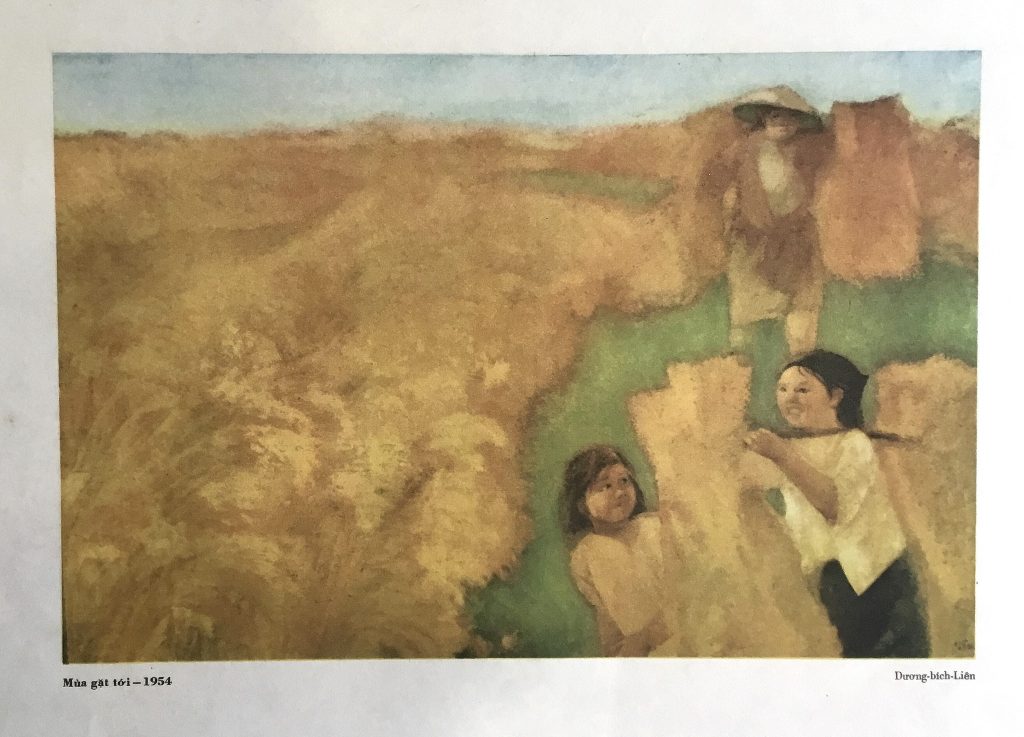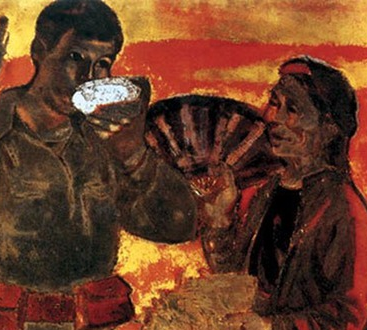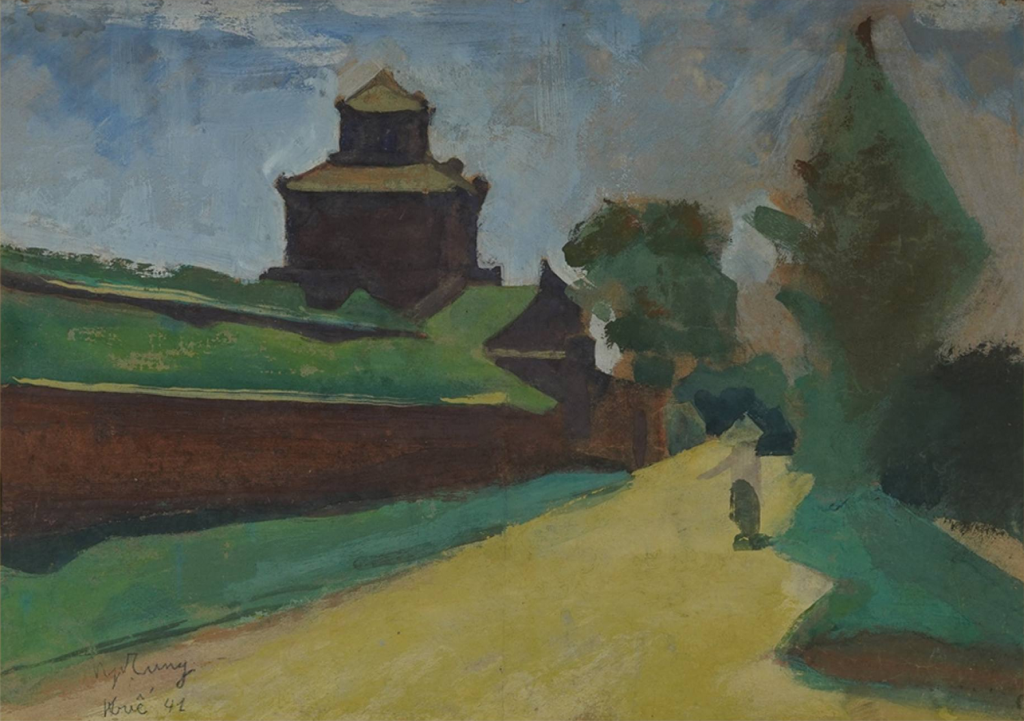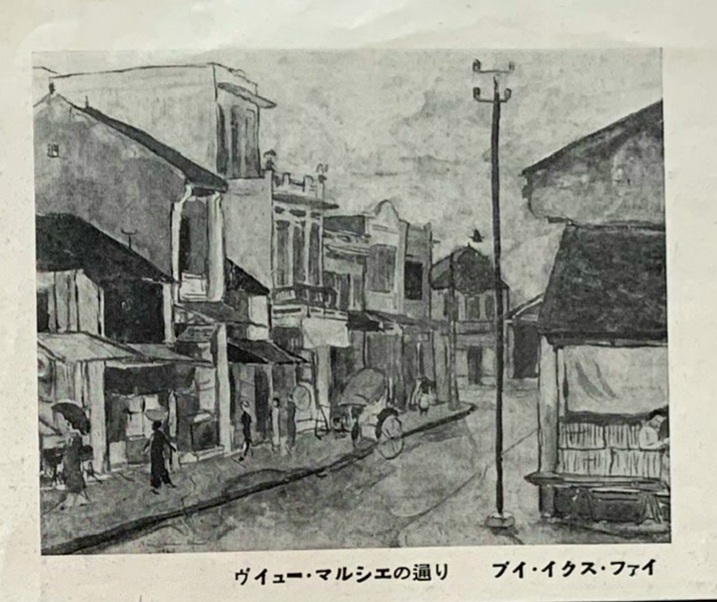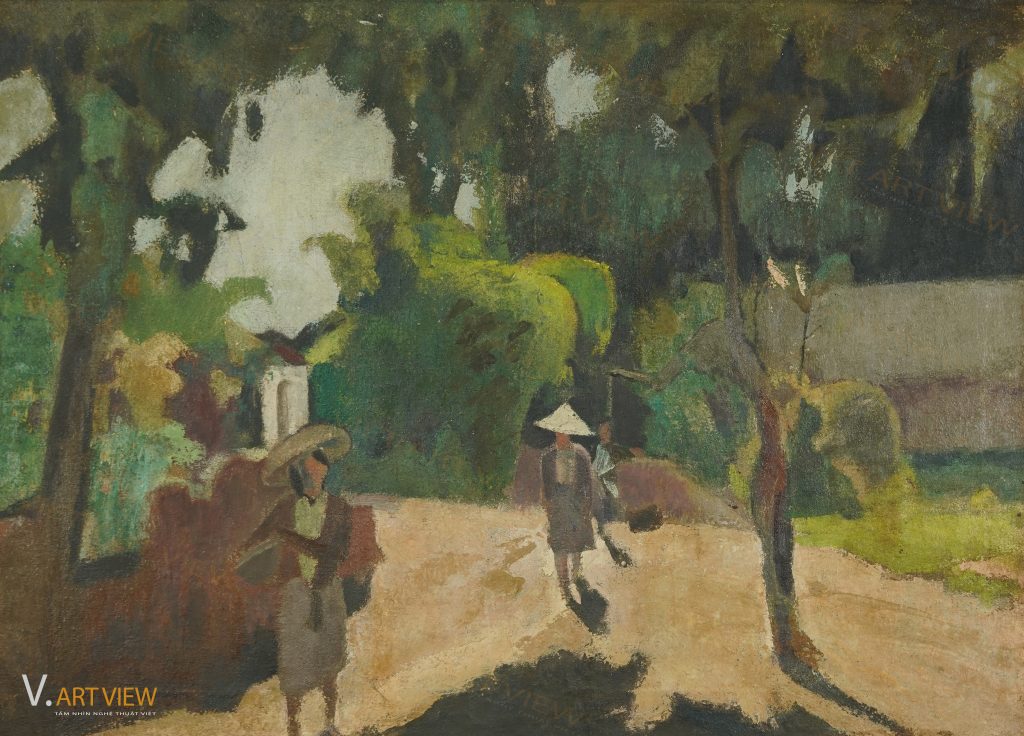
Joseph Inguimberty (1896-1971)
‘Village lane’. Circa 1935-1944. Oil on canvas. 50×70 cm.
From a famous painting in Việt Nam Fine Arts Museum
When we visit Việt Nam Fine Arts Museum, the rooms displaying artworks of artists from Indochina Fine Arts College always receive love and attention from the public.
In room number 9, the silk painting titled ‘Lady by the sofa’, 1934, silk, 96×35.5 cm by artist Lê Văn Đệ is admired and photographed a lot. The painting depicts a beautiful, noble young woman with a fresh face, dressed in an elegant Lemur áo dài.
Surely viewers wondered about the identity of the beauty in the painting.
On the occasion of researching the oil painting ‘Village lane’ created by Professor Joseph Inguimberty, Viet Art View recently discovered interesting details surrounding these two rare works of art. Because they used to belong to the same art collection.
The model in ‘Lady by the sofa’ is Ms Nguyễn Thị Bính (1911 -?), wife of Mr Hoàng Xuân Hãn (1908-1996) – a famous scholar, author of ‘La Sơn Phu Tử’; ‘Chinh phụ ngâm bi khảo’. Ms Nguyễn Thị Bính was a intellectual lady, first-class pharmacist, owner of the famous pharmacy “Pharmaice Hoàng Xuân Hãn” on Tràng Thi street.
In 1951, the couple went to Paris. After 1954, the country’s situation changed, Mr and Ms Hoàng Xuân Hãn did not return to Việt Nam and donating the entire pharmacy and assets to the Government.
Maybe after that, the paintings also left the family collection. Among them are the painting ‘Lady by the sofa’ of Lê Văn Đệ and the painting ‘Village lane’ of Joseph Inguimberty.
According to documents, the painting of Madame Bính was purchased by Việt Nam Fine Arts Museum from Mr Nguyễn Xuân Lâm (an art dealer in Hà Nội), house number 34, Cửa Nam street in 1962 for 150 VND.
Also around the 1960s, artist Bùi Xuân Phái and Mr Nguyễn Tường Huân somehow found the rare painting ‘Village lane’ by Inguimberty for Mr Nguyễn Văn Lâm. On the back of the painting there are two notes:
Nguyễn Tường Huân: “This is the oil painting by Inguimberty that Mr Phái and I found in Hà Nội and brought to Mr Lâm as a gift.”
Artist Nguyễn Khắc Cẩn appreciated: “I admire Mr Inguimberty and only now have I seen his painting – so touching and happy.”
For decades, Mr Nguyễn Văn Lâm had always displayed ‘Village lane’ in a solemn position of the family’s main living room at number 60 Nguyễn Hữu Huân. The room outside is the famous “Café Lâm” in Hà Nội.

The back of the painting
A lot of artists took photos with Mr Nguyễn Văn Lâm below this painting.
In 1997, in the exhibition “The Birth of Modern Art in Southeast Asia: Artists and Movements 1997” in Japan, Việt Nam Government sent 14 works to participate. These include 10 works belonging to Việt Nam Fine Arts Museum and 4 works belonging to the collection of Mr Nguyễn Văn Lâm; including ‘Village lane’.
Previously, in 1993, in the book ‘Painters of Indochina Fine Arts College’, editor Nguyễn Quang Phòng, Fine Arts Publishing House, 1993, page 35 respectfully introduced the painting.
According to art critic Quang Việt, he and his father – artist Quang Phòng personally cleaned the surface of this painting; Then took photos and introduced it in the book.
Joshep Inguimberty’s love for Việt Nam nature and people
Inguimberty had a passion for the magical beauty of Việt Nam. The beautiful landscapes in Kim Liên village, Đường Lâm, Hải Phòng, Hòa Bình and Sapa captured his heart and mind.
From the perspective of a talented artist, combining skillful academic painting techniques, a keen understanding of people, landscapes and above all, a special love for Vietnamese landscape has made Inguimberty’s paintings imbued with emotion. He portrayed Vietnamese nature and people realistically and deeply in the brilliant colors of Impressionism.
In 1929, his exhibition “Landscapes and people of the Tonkin Delta” was organized by Far East Printing Workshop in Hà Nội. It “made Vietnamese students shocked by the expressive power of oil… Vast fields – the curved high sky – village women dressed in brown with red belt carrying on the edges of fields.” Bamboo, banana standing together with rich green by the thatched roofs, the yellow-gray earth walls… Everything appears authentic and modern. Never before has the country of Việt Nam been so beautiful in paintings” (The book “Artists of Indochina Fine Arts College)
Feel the fresh nature in ‘Village lane’
Inguimberty had a special love for Kim Liên village (Hà Nội) and Đường Lâm village (Sơn Tây). Familiar places in Sơn Tây such as Đường Lâm, Và Temple, and Mía Pagoda are favorite practice locations for teachers and students of Indochina Fine Arts College.
It was in this place that he put the bamboo, the reddish-brown dirt road, the bright golden rice fields, and the dim green Ba Vì mountains in the distance into countless large-scale oil paintings.
Vietnamese countryside in Sơn Tây appears brilliantly and magically in a vast space filled with sunlight.
Inguimberty loved describing sunshine. He used the brightest midday sunlight to highlight the sense of light.
With ‘Village lane’, viewers find themselves in a summer afternoon full of golden sunshine. Several women wearing brown dresses, carrying baskets, were moving in the blazing sun. But the space does not evoke the typical hot feeling of the North. They are softened by the cool, multi-toned green of the vegetation.
At first glance, it seems that Inguimberty used pure colors to describe the scene. But in fact, the colors were mixed and layered. Looking closely at the shades, the darkest green seems to have no black presence (this is a basic characteristic of Impressionism).
Therefore, we have the feeling of being immersed in the gentleness and coolness of the bright light of nature rather than the feeling of hot sunshine.
Joseph Inguimberty is a painter of simple, realistic depictions. Therefore, what he showed on the surface of the painting identifies the exact location.
In his works about Kim Liên village, he often used images of pond edges, banana, bamboo, young women wearing modern áo dài leisurely chatting, men – sometimes appearing with strings of fish, and also babies.
Meanwhile, he described Sơn Tây with vast fields, red dirt village roads and farmers working or walking busily.
Whether he described nature or people, all of these scenes are filled with brilliant colors in the light. There is always a feeling of joy, excitement, and positive energy when facing the painting.
Joseph Inguimberty was born in 1896, died in 1971, at the age of 75. He went to Việt Nam in 1925 (at the invitation of Principal Victor Tardieu) when he was 29 years old and only returned to France in 1945, when he was 49 years old.
He spent the most beautiful and energetic 20 years of his life to attach with Việt Nam. This land has created in his soul a deep love for nature and people here. He transformed that feeling into passionate works of art, imbued with emotions in the brilliant colors and light of his own inner self.
Việt Nam, from his perspective of painting, becomes beautiful, poetic, rich in energy, and full of goodness.
To say about Inguimberty, there is no more accurate sentence than the comment of artist – researcher Quang Phòng (1924-2013): “Inguimberty is exactly like a Vietnamese artist, who knows and loves his homeland.”
Written by Viet Art View
Copyrights belong to Viet Art View


